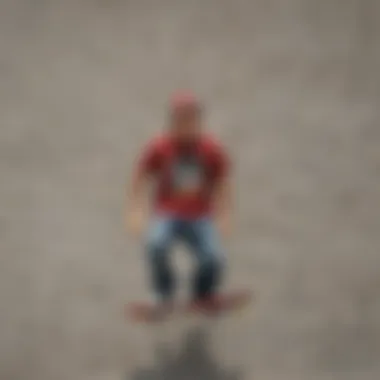Mark Gonzales: Impact on Skateboarding and Culture


Intro
Mark Gonzales isn't just a name in skateboarding; he’s a revolutionary figure that has shaped not only how the sport is perceived but also its relation with art and culture at large. Take a step back in time to Los Angeles during the 1980s, where Gonzales was honing his craft amidst a burgeoning subculture that was hungry for expression. His approach to skateboarding proved to be nothing short of ground-breaking. Unlike his contemporaries, Gonzales infused a creative flair into his riding style, often utilizing urban environments in ways that no one had ever considered before.
But it’s not just about the tricks. Gonzales has also transcended the boundaries of skateboarding; he’s carved a unique niche in the art world. From graffiti to more structured forms of visual art, he has expressed his experiences and thoughts, influencing an entire generation of artists and skateboarders. This dual influence he holds as both skater and artist makes him a compelling subject to explore.
Gonzales' philosophy revolves around creativity and rebellion, characteristics so deeply rooted in skateboarding culture. He has seen the sport evolve from niche to mainstream, all the while leaving an indelible impact that resonates across skate parks and galleries alike.
Now let’s take a closer look at how Gonzales not only changed skateboarding through innovative tricks but also how he melded these ideas into a broader narrative that challenges norms and inspires countless individuals.
Foreword to Mark Gonzales
Mark Gonzales stands as a titan in the worlds of skateboarding and art, a figure whose influence transcends mere trick execution and delves into the very fabric of cultural expression. Trouble brewed when one tried to pin down the essence of skateboarding in the late 20th century, but Gonzales transformed it into something more fluid and vibrant. The importance of examining his journey is not simply a chronicle of fame but rather an exploration of how one individual can ignite a movement. Gonzales embodies the spirit of rebellion and creativity that characterizes skate culture, forging an identity that resonates deep within both skaters and non-skaters alike.
Background and Early Life
Mark Gonzales, born on June 1, 1969, in Los Angeles, California, grew up in a melting pot of cultures that shaped his worldview. Surrounded by the sights, sounds, and skate parks of California in the 1980s, he was influenced by both the burgeoning punk scene and the rising waves of skateboard culture. His family, supportive and engaged, encouraged him to explore his creativity from an early age—this nurturing environment was fertile ground for his latter artistic inclinations.
Gonzales’ early years were marked by a searching spirit. As a teenager, he wasn’t merely a skateboarder in the making; he was a budding artist grappling with notions of expression and individuality. He would often wander through the city, not only looking for new spots to skate but also for inspiration in the graffiti art and urban landscapes that surrounded him. The blend of these experiences would create a unique perspective, merging sport with art long before the two realms were considered congruent in popular circles.
Initial Exposure to Skateboarding
Mark's relationship with skateboarding kicked off at the age of twelve when he was gifted his first skate deck. The freedom of movement and the thrill of mastering tricks captured him. The camaraderie found in local skate parks was something he'd latch onto. During this initial phase, Gonzales wasn't just learning tricks; he was experimenting—adding his flavor and flair to each maneuver. It was essential to him to break the mold and push past what was conventionally acceptable in the skating community.
One pivotal moment occurred when he attended an amateur skate contest. Instead of sticking to the prescribed tricks, Gonzales seized the opportunity to showcase his improvisational skills. The judges were taken aback; he encapsulated the very essence of skateboarding as both an art and a sport. From this point forward, it became clear that his journey would diverge sharply from traditional lines.
As he progressed through his teenage years, Gonzales became immersed in the skate scene, rapidly gaining attention not just as a skilled skateboarder but as an innovator on the board. His initial forays into skating laid the groundwork for a career that would see him transcending the traditional norms and expectations of the sport, ultimately leading to a dual legacy in skateboarding and art. This duality not only influences his life but inspires countless others who dare to blend their passions.
Skateboarding Innovations
Skateboarding Innovations mark a significant aspect of Mark Gonzales's impact on not only the sport but the culture surrounding it. His pioneering contributions have spurred a wave of creativity, influencing skateboarders everywhere. This section explores how Gonzales helped to reshape the landscape of skateboarding through his original tricks and his role in street skating, ultimately altering the very fabric of what it means to skate.
Pioneering Trick Techniques
Mark Gonzales is often regarded as a trailblazer in the realm of skateboarding tricks. From the get-go, he wasn’t one to follow the script set by his predecessors. Instead, he combined elements of artistic expression with athleticism, inspiring a generation to think outside the box.
One of the key innovations Gonzales introduced was the idea of skateboarding as a form of personal expression. He often integrated tricks that had up until then been considered impractical or abstract, like the ‘Gonz Gap’ — a move that required precision and flair. This creativity in trick selection prompted others to explore their styles more freely, breaking away from the stringent norms of traditional skateboarding.
Through his unique approach, Gonzales demonstrated that skateboarding could transcend mere sport; it is art in motion. Many young skaters began to see the board as a canvas, using it to paint their personalities through tricks.
"The board became a platform for my voice; it was never just about the tricks."
Mark Gonzales
The legacy of his techniques can still be seen in modern skateboarding, where individuality reigns supreme, and creativity has become the heart of the culture.
Impact on Street Skateboarding
Another vital contribution by Gonzales has been in the elevation of street skateboarding. Long before it became an Olympic discipline, he was shredding urban landscapes, transforming them into playgrounds for expression. By skating on unconventional surfaces like benches, ledges, and stairs, Gonzales exposed the potential of everyday environments as canvases for skateboarding.
Street skating not only expanded the locations and opportunities for skaters, but also changed the perception of what skateboarding could be. Mark showed that you didn’t need a skatepark to practice; the streets offered a plethora of ways to innovate and engage with a city’s design.
This evolution towards street skating encouraged a communal spirit as skaters collaborated and shared tricks, often creating informal contests right on the streets. This shift also allowed for a more inclusive environment, drawing people from various backgrounds into the skateboarding community.


Artistic Expressions of Gonzales
Mark Gonzales stands at the intersection of skateboarding and the art world, embodying creativity in a way very few manage to capture. His artistic versatility plays a pivotal role in understanding his multifaceted impact. Through art, he has reshaped skate culture, giving skaters a newfound identity—one that goes beyond mere tricks, reflecting their thoughts, emotions, and social perspectives. This section will delve into the importance of Gonzales's artistic expressions with a focus on their significance and impact throughout skateboarding and broader culture.
Influence on Skateboard Art
Gonzales's influence on skateboard art is monumental. He didn't just skate; he painted what he felt—literally. The skateboard as a canvas became an extension of his personality. With designs often inspired by his life experiences and surroundings, Mark Gonzales turned the act of skating into a dynamic form of self-expression.
Notable Elements of His Art
- Flow and Movement: Like skating, his artwork often represents fluidity, capturing the grace of movement.
- Raw Emotion: His pieces convey deep feelings, making the viewer think. It’s an honest reflection of the experiences he lived through.
- Innovative Techniques: Gonzales employs non-traditional methods, including incorporating everyday materials, pushing the envelope of what skateboard art typically involves.
Furthermore, his graffiti roots reflect a culture of rebellion. By blurring the lines between street art and skateboarding, Gonzales challenged the norms and offered a new narrative that cherishes individuality and authenticity. He didn’t just create art; he forged a identity for a generation of skaters.
Art Exhibitions and Recognition
Mark Gonzales's artwork didn’t just stay confined to the skate park. His pieces have graced galleries, showing that skate culture can be taken seriously in the art community. Exhibitions that feature his work have shifted perceptions, proving that skateboarders have something substantive to say.
Impact of Exhibitions
- Cultural Conversations: These exhibitions often spark dialogue about the intersection of art, lifestyle, and sports. They invite both skaters and the art community to engage in discussions that are often overlooked.
- Mainstream Acceptance: Gonzales's involvement in prominent galleries has contributed to the legitimization of skateboarding in artistic circles, expanding the audience for both arts and sports.
- Collaboration: Recognized by various brands and artists, he has collaborated with big names like Supreme and Nike, showcasing his art in ways that blend commerce with creativity.
Most importantly, the recognition he has received serves as a testament to the idea that skateboarding is not merely a sport but a complex cultural movement. Gonzales intertwined the seemingly opposing worlds of art and skateboarding, making a compelling case for their convergence.
"Art, for me, is just a canvas to explore life's possibilities, much like skating." – Mark Gonzales
As we transition to the next key points, keep in mind how Gonzales's artistic expressions not only elevate the skateboarding culture but also weave through the very fabric of contemporary art. His legacy in this domain continues to inspire countless artists and skaters, reminding everyone that expression knows no boundaries.
Cultural Contributions
Mark Gonzales is not just a skateboarder; he is a cultural icon whose influence reverberates throughout skateboarding and beyond. The importance of his cultural contributions can be seen in various aspects that transcend the confines of the skateboarding sphere. His ability to intertwine skateboarding with art, youth culture, and community engagement has elevated the sport into a language of its own. This section delves into how Gonzales’s influence has shaped the skateboarding community and inspired countless youths across generations, enriching their lives with creativity and expression.
Role in Skateboarding Community
Gonzales holds a pivotal spot in the skateboarding landscape, having established himself as a beacon for those who dare to express themselves through their boards. He’s more than a participant; he’s a leader who fosters a sense of belonging among skaters. His actions serve as a call to not just skate, but to skate with purpose and creativity.
- Community Building: Gonzales has been instrumental in creating spaces for skaters to gather, connect, and thrive. His involvement in skate events builds camaraderie among skaters, making them feel part of something larger.
- Mentorship: Many young skaters look up to him for guidance. Gonzales takes this role seriously, sharing tips, tricks, and philosophical insights on life through skating, which profoundly shapes the mentality of the next generation.
- Diversity and Inclusion: He has advocated for inclusivity in skate culture, encouraging participation among those from various backgrounds. This open-arms approach has cultivated a more diverse skateboarding community, allowing a wider array of creative expression.
Gonzales’s role transcends simply showing off tricks; he showcases how skateboarding can serve as a powerful medium for sharing experiences and bonding with others.
"Mark has made skateboarding feel like a welcoming canvas for everyone, not just the pros."
Influence on Youth Culture
The influence of Gonzales on youth culture is undeniable. His unique style and philosophy have resonated with young people, promoting a blend of freedom and self-expression that is crucial during formative years.
- Creativity: Mark’s approach to skateboarding encourages the youth to think outside the box. He shows that skateboarding isn't just about conformity; it's about joyful experimentation. As a result, many young skaters seek to invent their own tricks and styles, breaking from traditional molds.
- Rebellion and Identity: For many young people, skateboarding is a way to assert their identity and challenge societal norms. Gonzales embodies this spirit of rebellion through his work, making it relatable to youths who wish to carve their paths in the world.
- Art and Expression: Gonzales's venture into art fosters a connection between skating and artistic freedom. This intersection empowers youth to explore their artistic sensibilities, whether it's through graphic design on boards or street art, further validating their expression.
Mark Gonzales doesn’t just represent skateboarding; he serves as a catalyst for cultural change, showing that skateboarding can inspire not just athletes, but artists, thinkers, and tomorrow’s leaders.
In essence, his contributions to skateboarding culture, particularly regarding community and youth influence, render him a substantial figure, paving the way for a future filled with potential and creativity. We see now how Gonzales’s influence transforms not only skateboarding itself, but also the lives and cultures surrounding it.
Personal Philosophy


Mark Gonzales' influence in skateboarding isn't solely measured by his innovative tricks and artistic endeavors; it also flows deeply from his personal philosophy. His philosophy, which intertwines freedom and expression, cultivates a sense of belonging and community among skaters. It transcends the physical act of skating and bleeds into every facet of life. Understanding Gonzales' perspective on these topics provides insights into the cultural ethos that characterizes skateboarding.
Views on Freedom and Expression
For Gonzales, skateboarding is not just about the sport; it's a manifestation of freedom. It's about breaking boundaries and defying expectations, whether those are of society or oneself. He believes that, in skating, individuals truly express their inner voices. Their style, their tricks, and how they navigate space on a board become an extension of who they are inside. In his words, “Skateboarding is a dance on the streets, a form of personal expression.” This notion holds weight in the broader narrative of what it means to be a skateboarder — a continual challenge to societal norms and an embrace of one's individuality.
He often challenges skaters to look beyond the rules set out by others.
"If you enjoy what you do, it doesn't matter what anyone else thinks," Gonzales has said, a mantra that resonates across generations of skaters.
This viewpoint emboldens a sense of rebellion while simultaneously fostering creativity. The act of pushing the limits and exploring new territories reflects a broader human desire for self-actualization, be it through art or athleticism.
The Art of Skating as Life Philosophy
In Gonzales' world, the lines between art and skateboarding blur seamlessly. He embodies the belief that skating can be a form of art, not just an extreme sport. To him, the creativity exhibited on a skateboard - the unique tricks, the choice of urban landscapes, and the overall approach to skating - represents a dialogue with the environment. His belief turns every skate session into a canvas, and every move is a brushstroke in a larger masterpiece.
His philosophy suggests that life, like skating, demands improvisation and spontaneity. Just as no two skate spots are alike, no one's life path is either. These elements forge a connection among skaters, a unifying thread that ties individuals to a shared experience of creativity.
In this perspective, Gonzales encourages skaters to engage not just with the sport, but with the world around them, viewing obstacles as potential sources of inspiration instead of hindrances. Through skateboarding, one learns resilience—using even failures as stepping stones to push further and create art through movement.
This outlook is a crucial part of his legacy, affecting how current and future generations approach not only skateboarding but also life beyond the board.
By embedding freedom and expression into the very essence of skating, Mark Gonzales continues to inspire countless individuals to carve their own paths, both on and off the skateboard.
Mark Gonzales and the Evolution of Skateboarding
Mark Gonzales has been a transformative figure in skateboarding, acting as a catalyst that brought the sport into new realms. His contributions go beyond just executing awe-inspiring tricks; they speak to a larger evolution of culture surrounding skateboarding. The shifts Gonzales has spurred cover everything from the tricks performed on the streets to the way skateboarding is perceived globally. Understanding his role is fundamental to grasp the contemporary landscape of skateboarding, where creativity and community intertwine in ways that were hardly envisioned in earlier decades.
Key Milestones in Gonzales' Career
Mark's journey dates back to the 1980s in California, where he first gained prominence riding for companies like Santa Cruz Skateboards. One key moment was when he debuted the now iconic trick, the "Gonz Gap," which pushed the boundaries of what was possible on a skateboard. It wasn't just a catching move; it symbolized a shift towards street-oriented tricks that many now take for granted.
- As his tricks evolved, so did his style. He incorporated elements from urban culture, which stood apart from the aggressive competition style typical of that time.
- In 1994, Gonzales co-founded the skateboard company Blind, fostering a new generation of skaters who embraced his vision of creativity over conformity.
- In the early 2000s, he floated the idea of skateboarding being an art form, which led to collaborations with numerous artists and exhibitions showcasing skate-related artworks, blending sports with artistic expressions.
Each milestone has cemented Gonzales' status as more than just a skater; he became a pioneer who blazed a trail for others to follow, emphasizing that skateboarding and artistry could coexist.
Technological Changes and Adaptations
The evolution of skateboarding often parallels advances in technology, which Gonzales embraced throughout his career. The early skateboards were wooden and heavy, limiting the types of tricks skaters could attempt. With time, lightweight materials and improved designs emerged, changing how skaters approached their craft.
- Change in Deck Materials: With the introduction of lighter, more resilient materials like polymer composites, skaters could perform tricks with greater ease and less risk.
- Grip Tape Innovations: Upgrades in grip tape led to better control, enabling trick variations that were previously thought to be impossible. Gonzales utilized these advancements in his performances, often experimenting to find creative uses for new equipment.
- Filming Technology: The increase in accessibility of high-quality video recording changed the game completely. Gonzales embraced this, showcasing his tricks through various skate videos that not only documented but immortalized his innovations on the skateboard.
The adaptability of Gonzales in light of technological advancements illustrates an essential truth in skateboarding: evolution doesn’t happen in a vacuum but rather thrives on the symbiotic relationship between creativity and technological progress.
"Skateboarding isn't just about the tricks. It's a dialogue - between the skater, the board, and the world around them."
In essence, Mark Gonzales represents a confluence of talent, adaptability, and foresight, marking significant points in the evolution of skateboarding as a cultural and recreational practice.
Legacy and Influence
Mark Gonzales' legacy within skateboarding isn't just a simple footnote in the history of the sport; it's a bold underline that documents a transformative era. His influence lurks in the corners of skate parks and resonates through the lyrics of countless musicians, reflecting the cultural proliferation that he sparked in the 1980s and 90s. Folks from all walks of life, including surfers, paddleboarders, and instructors, can draw inspiration not just from his tricks but from the sheer audacity he embraced in his approach to his craft.
The fabric of skating has been interwoven with Gonzales' fearless spirit, which reflects a collective desire for self-expression and rebellion. His legacy is a reminder that skateboarding is more than just a mode of transportation or a competitive sport - it’s about individualism and creativity. Gonzales famously merged artistry and skateboarding, pushing boundaries that often seem insurmountable. Below, we explore two vital aspects of his legacy.


Impact on Future Generations
Gonzales has had a profound impact on the new breed of skaters who look to him for inspiration. His style of skating encouraged young enthusiasts to embrace creativity over conformity. They don't merely replicate his tricks; they transform them, remixing old concepts into new expressions.
- Innovative Spirit: Mark’s ability to think outside the box fostered a sense of innovation among future generations. Surfers and other action sports athletes have seen the value in breaking traditional molds, whether it is through experimenting with different tricks or mixing their sport with other artistic expressions.
- Cultural Connection: The camaraderie among skaters today bears the mark of Gonzales. As a bridge between the subcultures of skating and art, he has imbued a new level of consciousness, prompting young skaters not just to push their physical limits but to be conscious of their influence in society too.
"Mark’s influence reached far beyond tricks; it carved out an identity for skaters that blended art with athleticism."
Continuing Influence in Contemporary Skateboarding
Even decades after his initial stardom, Gonzales' fingerprints are all over contemporary skateboarding. Modern skaters reference him not only in their tricks but also in their aesthetic choices. He has shaped how skating is perceived both inside and outside the community.
- Developing Trends: Current trends in skateboarding—be it freestyle moves or the resurgence of artistic designs on boards—often find their roots in Gonzales’ pioneering work. Brands that cater to skateboarders unabashedly look to him for branding and design inspiration.
- Community Engagement: Gonzales facilitates a sense of community that persists today, encouraging present-day skaters to participate in collaborative projects and share their artistic journeys, paralleling old-school street art movements with modern skate culture.
This ongoing legacy keeps him a relevant figure in discussions about skateboarding and culture. It's as though Gonzales infused a spirit into the skateboarding world that continually regenerates, ensuring that both the sport and its cultural significance endure for years to come.
Critical Reception
The topic of critical reception, especially in relation to Mark Gonzales, is a profound reflection of the intersection between skateboarding and broader cultural values. This section serves to unpack how Gonzales’ contributions have been perceived within various media outlets and among critics, who have often had dual roles—as both aficionados of skate culture and observers of its evolution.
Media Coverage and Documentation
Coverage of Gonzales in media has been a double-edged sword. On one hand, his innovative techniques in skateboarding garnered widespread acclaim, almost glowing tributes from skateboarding magazines and lifestyle publications alike. Journals like Thrasher often highlight not just his stunts but also his unique style.
Conversely, his artistic ventures—such as his colorful, abstract skateboard designs—have led to heated discussions among critics who oscillate between admiration and skepticism. For example, some skateboarding documentaries feature Gonzales prominently, illustrating not just his influence on the sport but also his philosophy on life itself. This coverage has effectively documented the evolution of both a skater and a cultural icon, thereby cementing his legacy in the annals of skating history.
In essence, the media has played a crucial role in framing how Gonzales is viewed today. His story is not merely a personal chronicle but a representation of how skateboarding intersects with creativity and rebellion. Reports and documentaries capture the essence of Gonzales but also invite viewers to question the very foundations of skate culture itself.
Critics’ Perspectives
Critics have long scrutinized Gonzales’s reach not just from a skating perspective but also in his broader cultural impact. Many saw him as a bridge between the gritty reality of street skating and the polished world of gallery art. Reviewing his influence, one could say that it’s akin to having a bird on a wire—swaying between two worlds continuously.
- Positive viewpoints: Many critics appreciate his ability to elevate skateboarding into an art form. Critics in publications like Rolling Stone have noted how Gonzales’s creative output serves to inspire countless young skaters to merge their passions. They see a figure who is not just a skater, but a creator defined by spontaneity and vision.
- Constructive critiques: On the other hand, some say that Gonzales' blurring of skating and art can sometimes dilute the authenticity sought by traditionalists in the sport. This tension enriches the discourse around what it means to be an athlete in an art-infused environment.
"Mark Gonzales is more than just a name in skateboarding; he's a catalyst that challenges the boundaries of both art and sport," a prominent critic once stated.
This ongoing dialogue regarding Gonzales’s contributions encapsulates broader themes in sports culture. Ultimately, the reception of Gonzales—marked by a blend of reverence and critique—reflects the complexities of skateboarding as an evolving cultural narrative. With every flip and trick, Gonzales transcends the role of a mere athlete, embedding himself deeply into the very fabric of cultural conversation.
Closure
The culmination of insights into Mark Gonzales’ influence underscores a striking reality: he’s more than just a skateboarder; he’s a cultural phenomenon. His contributions reach into the heart of skateboarding, intertwining innovative techniques with potent artistic expressions. The narrative established throughout this article hinges on this multifaceted impact, illuminating how Gonzales has shaped not just his immediate community, but also the broader cultural landscape.
Reflection on Gonzales’ Impact
Mark Gonzales has left an indelible mark on skateboarding, defining and redefining the sport in unique ways. He pioneered tricks that seemed impossible to most, turning urban environments into blank canvases for self-expression. The question often asked is: What sets Gonzales apart?
Gonzales exemplifies the spirit of creativity. One can see this not only in his skating but also in his art, which boldly captures the essence of street culture. His ability to blend skating with creativity showcases an authenticity that resonates with many, especially those who find themselves on the fringes of traditional sports. The way he skates, seemingly dancing with the board beneath his feet, communicates freedom. It's like he whispers to the world that the rules of skating can not only be bent but can be beautifully broken.
Moreover, his role as a bridge between skateboarding and the ever-evolving art scene cannot be understated. He shows that creativity has no bounds. This, in turn, inspires younger skaters to not just replicate moves but also to infuse their personal stories into their skating. Thus, the legacy he leaves is not merely about trick lists; it's about a lifestyle choice that prioritizes artistic expression just as much as athletic prowess.
The Enduring Spirit of Skate Culture
Skate culture is often regarded as a rebellious force, one that challenges societal norms and expectations. Mark Gonzales encapsulates this spirit perfectly. As someone who navigated through the complexities of skating in a time when it was often marginalized, he remains a beacon of what it means to embrace individuality.
Gonzales' skateboarding style—a blend of technical skill and artistic flair—has paved the way for future generations to explore their own identities through skateboarding. The essence of skate culture lies in community, experimentation, and self-definition. With Gonzales as a major influence, skaters are invited to create, to engage with their environment, and to redefine the barriers between art and sport.
"Skating is like painting with your feet, creating masterpieces on the streets."
This intertwining of art and skating reflects a larger trend within the culture, where expression is valued over competition, and collaboration supersedes isolation. In a fast-changing world, Gonzales’ legacy resonates, reminding us why skate culture thrives—because it encourages one to be authentically oneself, regardless of external pressures. His relentless spirit continues to inspire, proving that whether on a board or with a brush, creativity remains at the heart of skateboarding.



